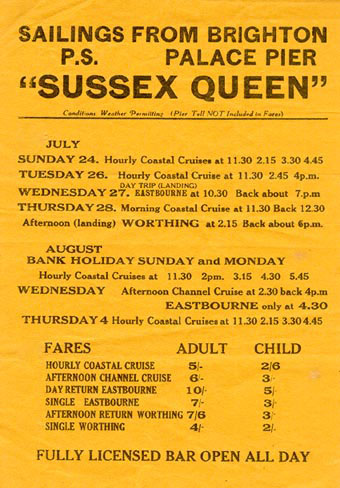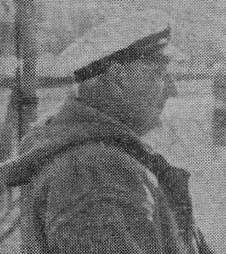
Whilst sailing aboard the British Railways’ 152ft long paddle steamer Freshwater from Yarmouth to Lymington in the summer of 1959, Professor Alan Robinson heard that the ship was to be withdrawn and, becoming concerned at the increasing rate at which paddlers were being sent off to the scrapyard, hatched the idea of founding the Paddle Steamer Preservation Society. A letter to a national newspaper started the ball rolling and by September of the following year the society, which then had a membership of around sixty, started their fundraising by chartering the paddle steamer Consul for an evening cruise from Weymouth.
Freshwater was duly withdrawn but, against expectations, was bought by a Mr Herbert Jennings who decided to launch his own paddle steamer preservation project putting the ship into service sailing from Brighton, Eastbourne and Hastings on the Sussex coast filling a gap left by P & A Campbells’ withdrawal from the area a couple of years before. It was a brave decision for Mr Jennings and the less than happy results were a hard lesson to learn.

Newly renamed Sussex Queen, the ship did not arrive in time to start the sailings advertised in this steamer notice. On 19th June the editor of the Eastbourne Gazette wrote to the company “We are sorry that the last minute interruptions have meant so much extra work for you all. When your programme eventually begins we are hoping to get pictures of your first arrival at Eastbourne.”
In a scrapbook which he kept and which we now have in our archives, Mr Jennings fills out more details of these last minute interruptions. He recounts:
After great difficulty in getting started after all the overhaul work was carried out we were delayed for nearly a month in getting the radio installed (she had not needed one for her railway ferry work inside the Solent) with all this time wages going out at the rate of £300 per week plus harbour dues and fuel costs. Another problem was crew. Steam engineers were people of a past age, firemen for a coal fired ship all dead and when a good one was found a pig-headed half Scot upset him so we lost him. Of the deck crew they were generally a scruffy lot of British Rail throw-outs. The mate had little authority. The purser/radio officer was useless and quite unable to look after the tickets or cash.The number of passengers leaving the vessel never tallied with the tickets issued or the money handed in.

Mr Jennings had had the right idea in trying to appoint a former P&A Campbell paddle steamer captain, Neville Cottman, as master but he became ill and was not able to join the company. A Capt Collin brought Sussex Queen to Newhaven but for much of the summer she was under the command Capt Kane, a former chief officer of Red Funnel Steamers’ Solent Queen.

Later sailing bills were in a different and cheaper format as money for the project began to run out.
The scrapbook doesn’t give a date for the start of the trips but an undated cutting from the Eastbourne Gazette reports:
Unable to announce her initial trip from Eastbourne on Thursday beyond chalked wording on a blackboard at the pier entrance, Sussex Queen took sixty passengers for a trip round the Royal Sovereign lightship. She enjoyed good weather for this and the afternoon trip to Hastings and the total passenger load for the day was one hundred and thirty.

At the end of the season Mr Jennings wrote in his scrapbook:
Standing on the end of the pier I watched my steamer swing and lay a course for Newhaven around Beachy Head. I watched her disappear into the setting sun. To me it was a sad sight. I felt very lonely as I pondered if this was to be her last trip from Eastbourne. Regrettably it was. Due to the bungling of our affairs by my company’s solicitor we lost our concession with the Palace Pier Company.

Sussex Queen retired to Topsham on the River Exe for the winter where she was pictured the following April after some wag had painted out the Sus of Sussex in the name on the bow.

Another view of the ship at Topsham taken by Terry Lewis
For 1961, Mr Jennings had further plans. If he couldn’t go back to the Sussex Coast he would try elsewhere. He recounts:
Many alternatives were considered including possible limited operation in the Bristol Channel jointly with P & A Campbell but this fell through and I was thrown back onto fighting my way into Bournemouth where an opening existed owing to Cosens having disposed of their Monarch. Fight my way it was with every obstacle being placed before me. This is a story of most unbelievable intrigue and even sabotage.
Renamed Swanage Queen, the ship did sail from Bournemouth in 1961 running mostly on the Swanage service and one day a week to the Isle of Wight but the short nine week season was not a success. Once again crew problems were endemic. Unwelcome national publicity came with the ship being stranded overnight at sea with passengers aboard in thick fog. And at one stage Swanage Queen nearly sank alongside Poole Quay, Mr Jennings believing that someone had deliberately opened her sea-cocks.
After the season Swanage Queen was put up for sale and in February 1962 was bought by a company set up by Capt Townsend, founder of the Dover/Calais ferry company of that name who initially hoped to put her back into service. By this time the Board of Trade were beginning to take a most stringent interest in elderly paddle steamers changing hands so more problems arose and in April she was put on the market again finding her final resting place in the scrapyard in Belgium the following month.

For all his difficulties and ultimate lack of success with paddle steamer preservation and operation, I cannot help but admire Herbert Jennings (pictured above). At a time when paddlers were going to the breakers at an ever increasing rate he tried to stem that tide. He put his money where his mouth was. And he worked tirelessly to achieve that goal.
Although his ship has long gone, her memory and her legacy remain. If Professor Robinson had not travelled aboard her in 1959 there would not be a PSPS today as we know it. And her place in history is secure as the first paddle steamer in this country which anyone tried to preserve.
Never daunted, the indefatigable paddle steamer loving Mr Jennings made subsequent unsuccessful enquiries about buying the Medway Queen. But despite all these difficulties he continued to be involved with passenger vessels successfully running a smaller launch from his home town of Exmouth for very many years after.
Kingswear Castle returned to service in 2023 after the first part of a major rebuild which is designed to set her up for the next 25 years running on the River Dart. The Paddle Steamer Kingswear Castle Trust is now fund raising for the second phase of the rebuild. You can read more about the rebuilds and how you can help if you can here.
John Megoran


